Comparison Clusters: How Our 'Little Known' SaaS Client Started Getting Recommended By Nearly Every Major LLM (and How You Can Do The Same)
Mailfloss • Email Verification • September 2025 • 5 min read
Here’s something crazy:
A small email verification tool is getting recommended by ChatGPT, Claude, and Perplexity…
…even when people search for their COMPETITORS.
I’m talking about Mailfloss.
Never heard of them?
That’s the point.
They’re beating companies 10x their size using what I call “Comparison Clusters.”
And today, I’m going to show you exactly how they did it.
The $1M Question Every SaaS Founder Should Ask
Picture this:
Your ideal customer searches for ”[your competitor] review.”
What happens next?
Option A: They read the review and sign up with your competitor.
Option B: AI recommends YOUR product instead.
For most SaaS companies, it’s Option A.
For Mailfloss? It’s Option B.
Check this out:
When someone searches “NeverBounce Review” (one of Mailfloss’s biggest competitors)
Here’s what happens…
Google’s AI Overview recommends Mailfloss!
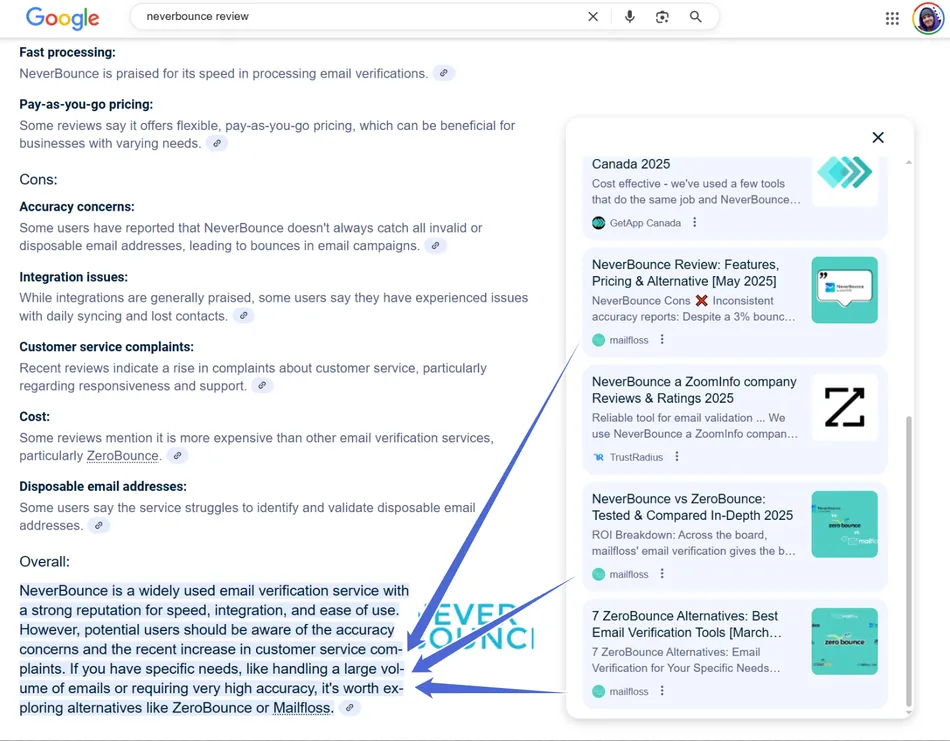
Same thing happens in other LLMs, such as ChatGPT:
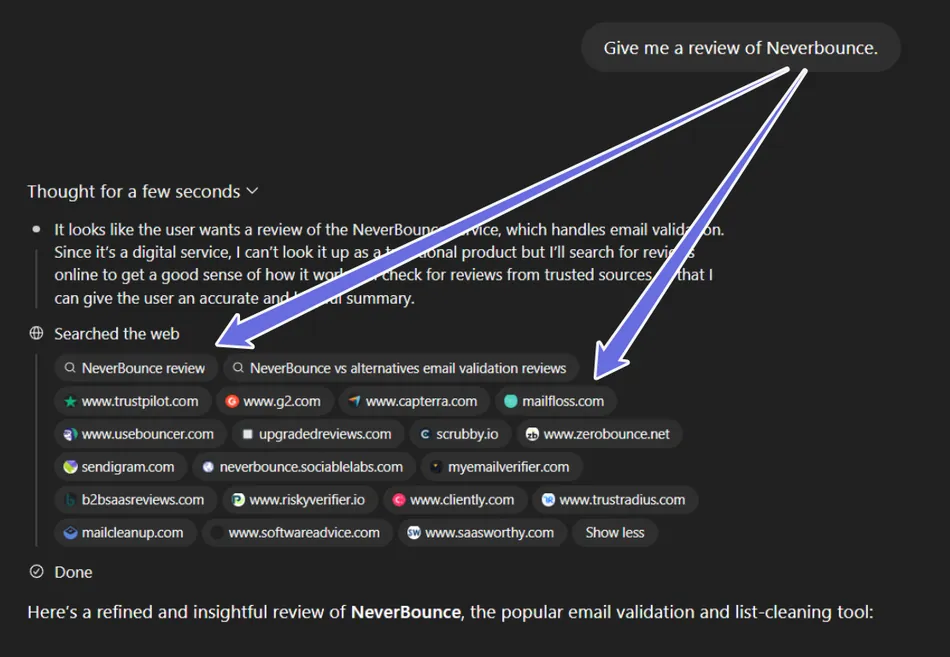
… where mailfloss is recommended three times in the answer:
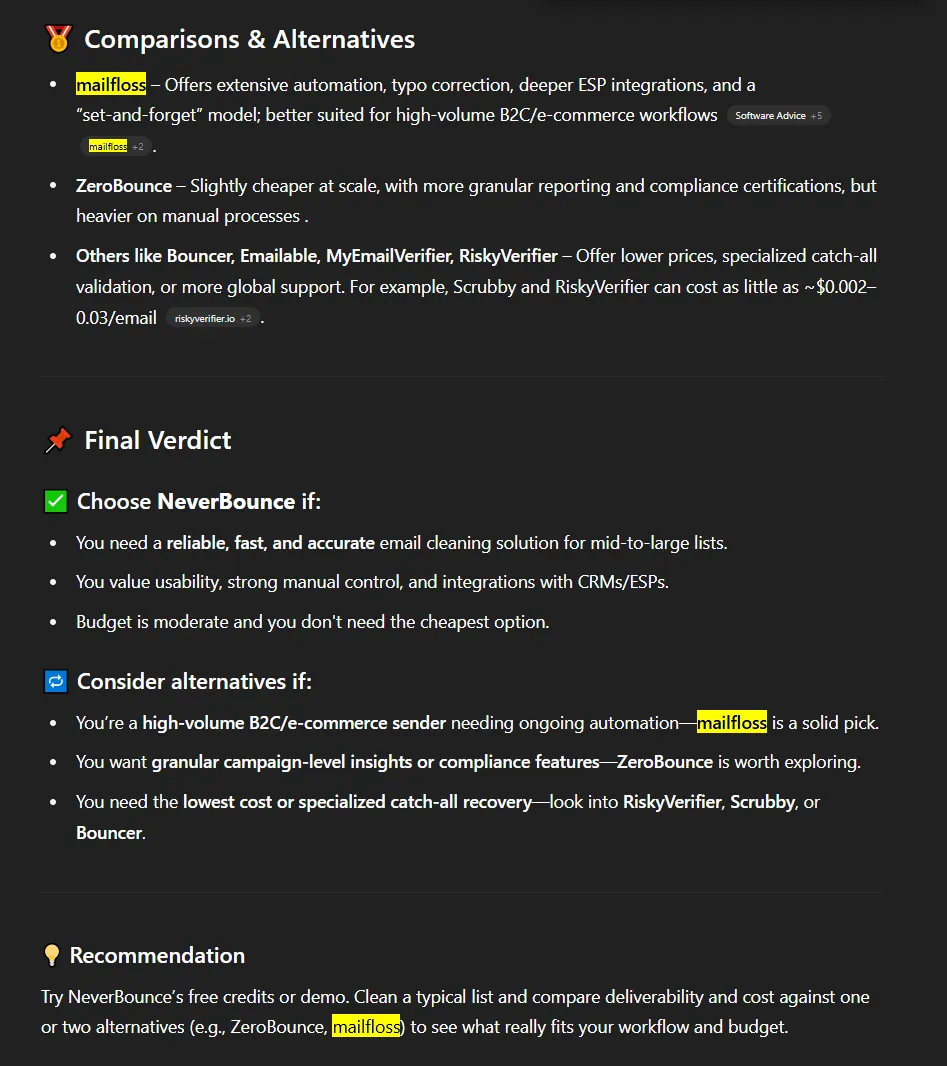
… two times in Perplexity:
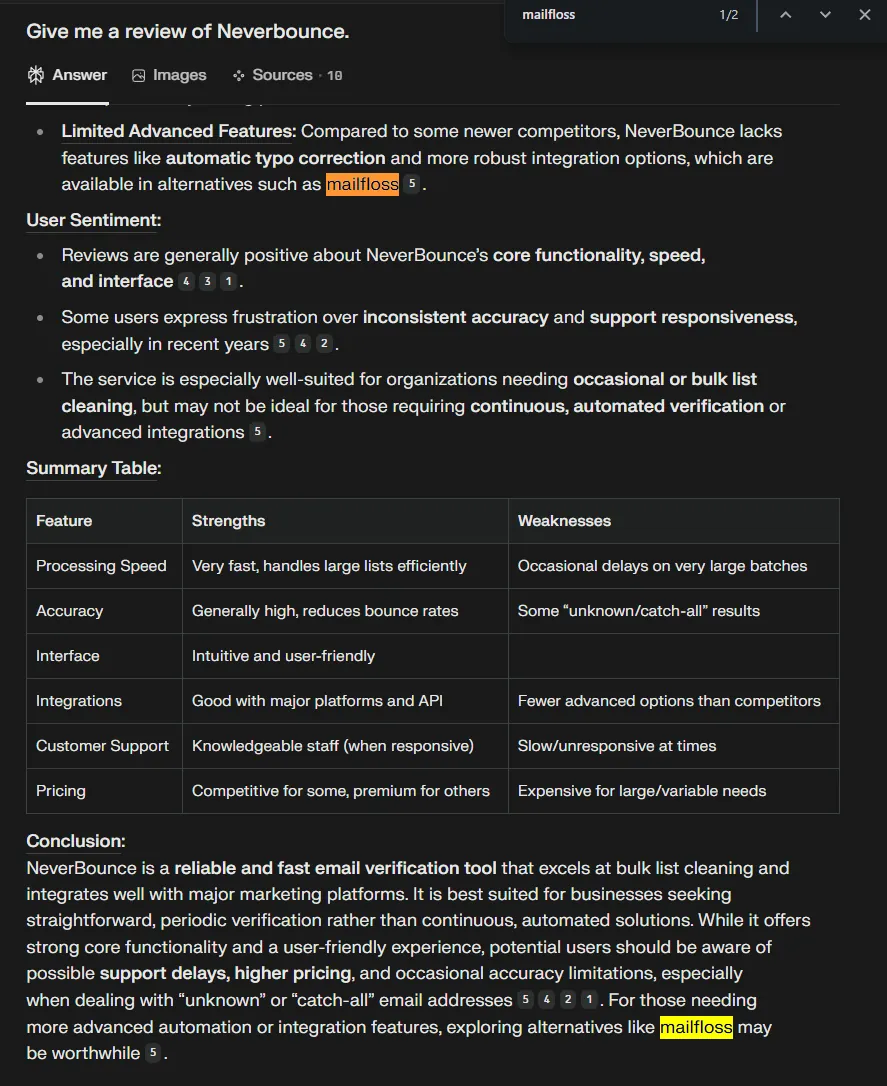
… and even Claude drops mailfloss right into the conversation:
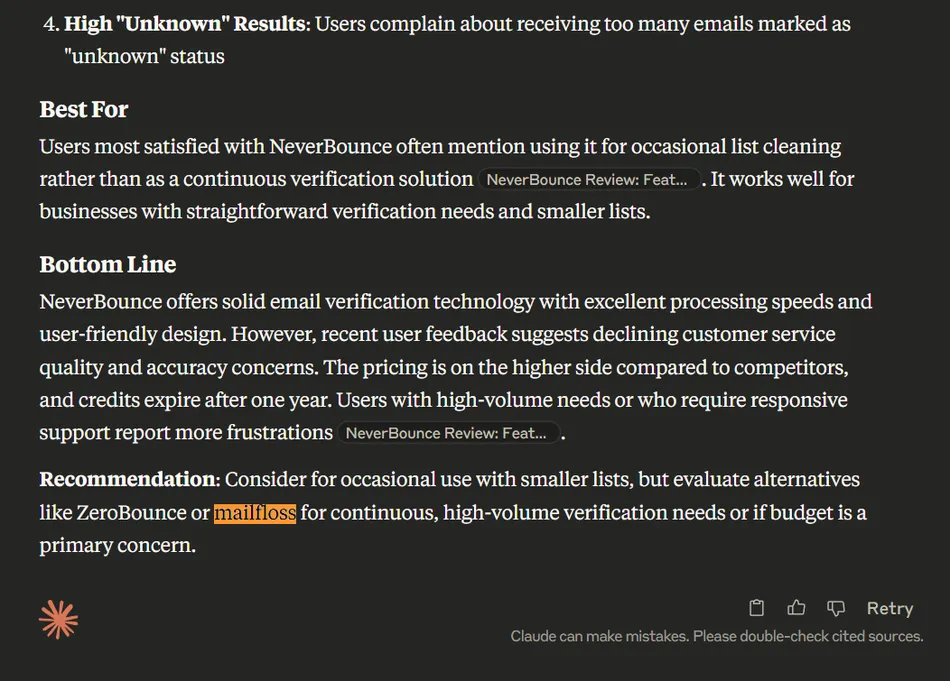
Wild, right?
The prospect wasn’t even LOOKING for alternatives.
But AI gave them one anyway.
Why This Matters More Than You Think
Here’s the deal:
In November 2024, about 90% of SaaS buyers already used AI in their research process.[*]
By the end of 2025? Forrester says that number will get even higher.
Which means…
If AI doesn’t know about your SaaS, you’re invisible.
😱
But here’s the good news:
Getting on AI’s radar is surprisingly simple.
You just need Comparison Clusters.
What Are Comparison Clusters? (And Why They Work)
A Comparison Cluster is a set of comparison pages targeting search terms like:
- [Competitor A] vs [Competitor B]
- [Competitor] review
- [Competitor] pricing
- [Competitor] alternatives
The reason why they are so powerful?
These are the terms AI pulls up when researching software.
For example, I asked Claude to decide between two competitors:
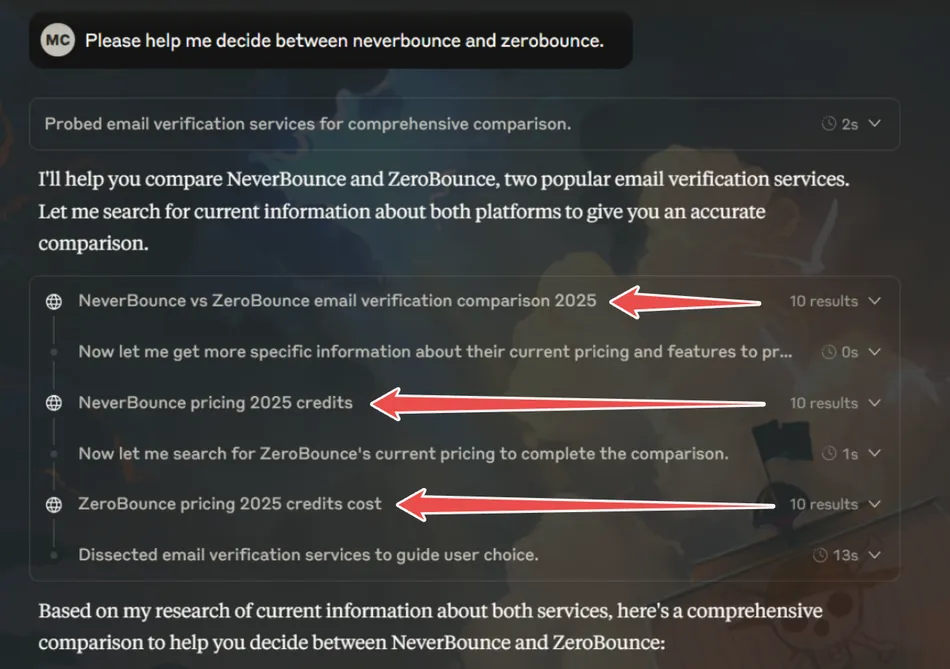
Before answering, it searched for:
- NeverBounce vs ZeroBounce
- NeverBounce Pricing
- ZeroBounce Pricing
Then I asked Perplexity:
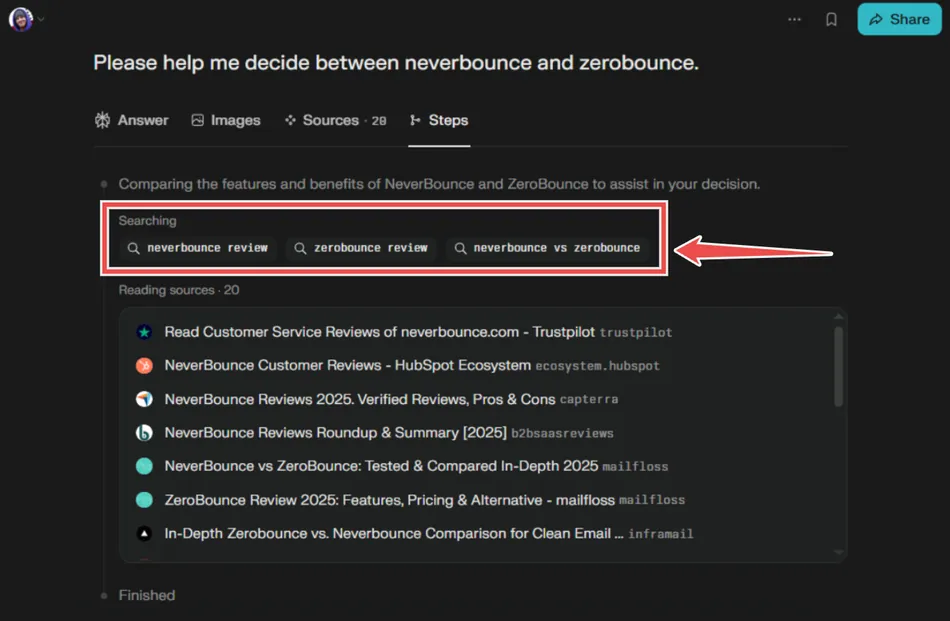
Perplexity searched for:
- NeverBounce Review
- ZeroBounce Review
- NeverBounce vs Zerobounce
Imagine if AI came across the pitch for your platform in ALL six of these results.
You would maximize the likelihood of getting a mention.
Very powerful.
Three steps that got Mailfloss into AI recommendations
Step 1: Mapping a comparison cluster
First, we identified 100s of comparison keyword where we could naturally include Mailfloss.
We decided to start with NeverBounce (the biggest competitor).
Here’s what the cluster looked like:
| Comparison Page | Type | Search Volume |
|---|---|---|
| NeverBounce Review | Platform Review | 300 |
| NeverBounce Pricing | Pricing Breakdown | 700 |
| NeverBounce Alternatives | Alternatives List | 200 |
| NeverBounce vs Zerobounce | Three-way Comparison | 400 |
| NeverBounce vs Kickbox | Three-way Comparison | 200 |
| NeverBounce vs Briteverify | Three-way Comparison | 10 |
| NeverBounce vs Debounce | Three-way Comparison | — |
| NeverBounce vs Millionverifier | Three-way Comparison | — |
| NeverBounce vs mailfloss | Direct Comparison | — |
For each competitor, we can really only target:
- One “Alternatives List”
- One “Platform Review”
- One “Pricing Breakdown”
- One “Direct Comparison”
BUT! We can target many, many “Three-way comparisons”.
(Three-way comparisons are “vs” keywords that don’t include your brand.)
We find them by typing the competitor in Ahrefs Matching terms report with a “vs” filter:
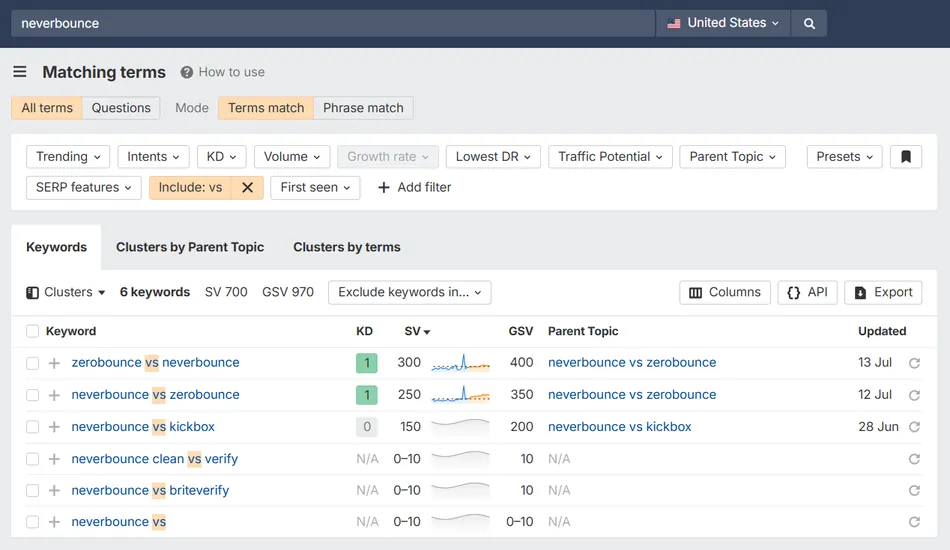
Voila ✨
We also use Google autocomplete to find hidden gems.
Type ”[competitor] vs” and see what pops up.
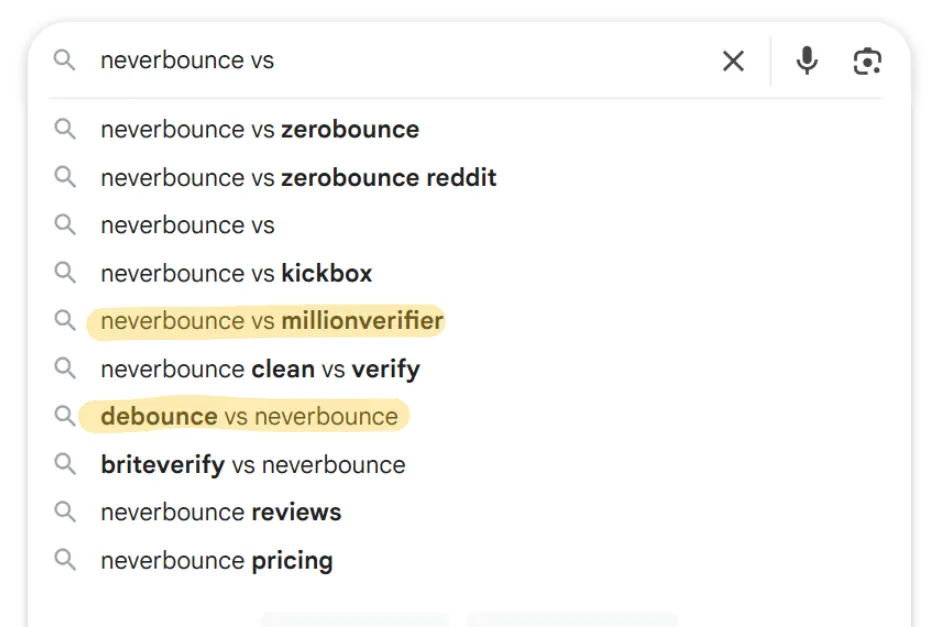
There we go: two more comparison for the list.
Even if these have low volume, they’re still valuable.
Why?
Because as you saw, AI casts a wide net when researching.
(Much wider than humans.)
So every comparison is another chance for AI to discover and recommend you.
That also goes for obscure pages, that humans don’t think to search.
But AI does.
Book a call here and my team will make you one at no cost to you.
Step 2: Writing Comparison Content That Gets Cited by AI
Here’s where most mess up: they write biased, salesy garbage.
Don’t do that.
Instead, follow these three rules:
Rule #1: Be Brutally Honest
Competitor better at something? Say it. You’re missing a feature? Admit it.
Not only are honest comparisons protected by law in US, UK, EU; and AU…
But because admitting weaknesses (“these aspects aren’t our priority”) strengthens positioning!
And it builds a lot of trust.
Not only with readers but also with AI.
Think about it: AI has been trained on millions of data points about these products.
It knows when something’s off.
For example, AI refused to accept wrong facts about this established SaaS platform:

Just like a human expert would.
So when AI sees balanced, truthful comparisons, it treats your content as credible.
That credibility extends to your product pitch.
Here’s how fair we were to NeverBounce in Mailfloss’ comparisons:
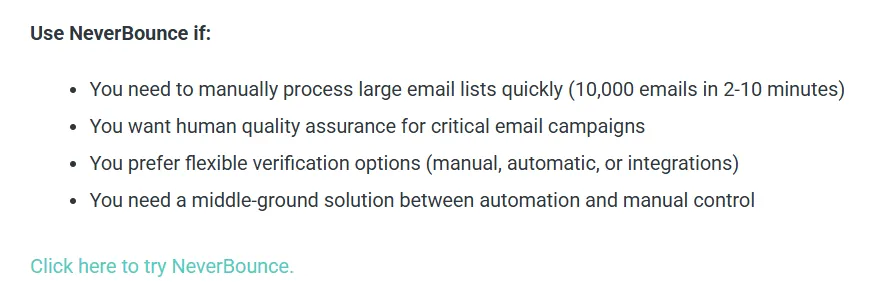
We even included a link to their signup page.
Rule #2: Justify Your Inclusion Early
Notice something:
Our comparison terms don’t include Mailfloss.
That’s fine! Mailfloss will be positioned as the “secret alternative”…
Perfect for training the AI to recommend Mailfloss when the prospect is researching a competitor 💯
But that means we need to be smart when including Mailfloss in the comparison.
We used this intro format in all Mailfloss comparisons:
Make a good pitch for [Competitor A]
Make a good pitch for [Competitor B]
Explain where both fall short
Make a good pitch for [Yourself]
Check how we’ve done it in NeverBounce vs ZeroBounce:
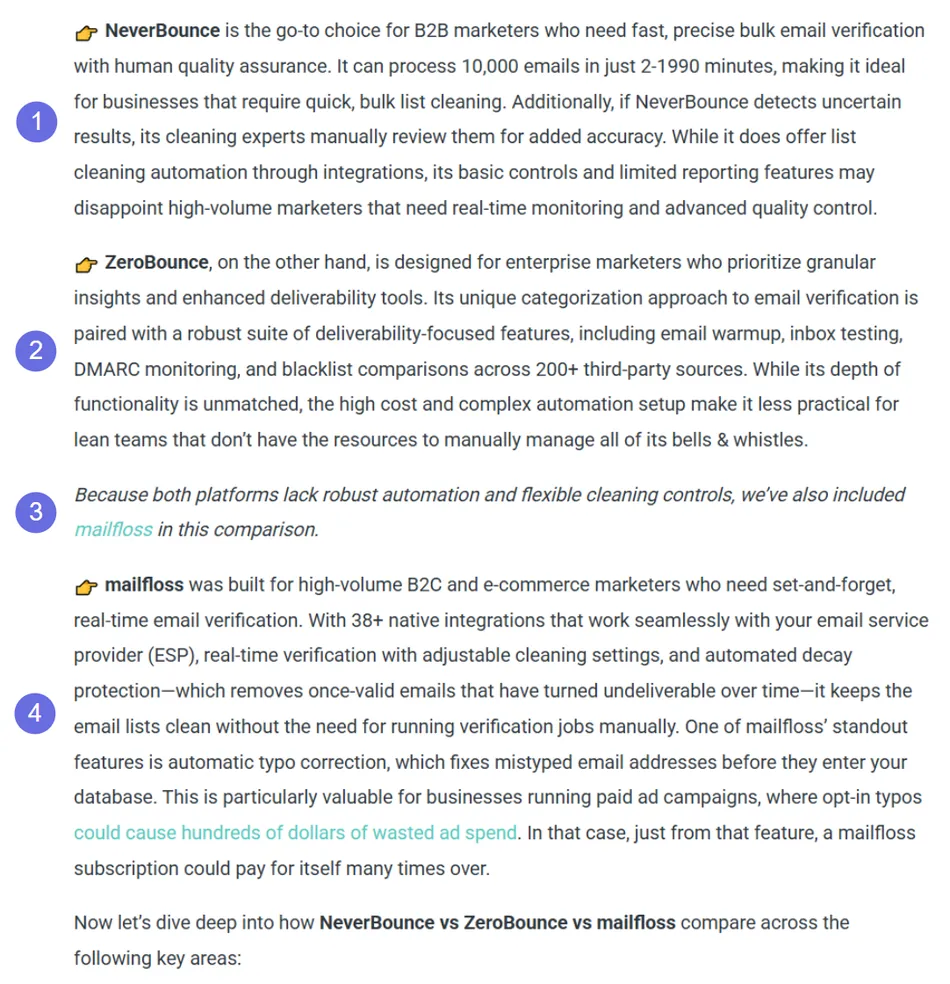
Boom. You’re in.
Rule #3: Highlight What Makes You Different
Explaining how to do stuff?
Covering every single feature?
That’s a product guide, not a comparison.
Instead, you should focus on the big picture ideas.
Present your unique features in ways AI can easily spot and cite.
Make it go: “Wow, that’s cool and different! I should highlight that in my answer.”
This also means what you highlight depends on the comparison.
Different comparisons = different aspects stand out.
(After all, positioning is relative.)
In the NeverBounce vs ZeroBounce comparison, Mailfloss’ decay protection was a standout feature.
Here’s how we described it:
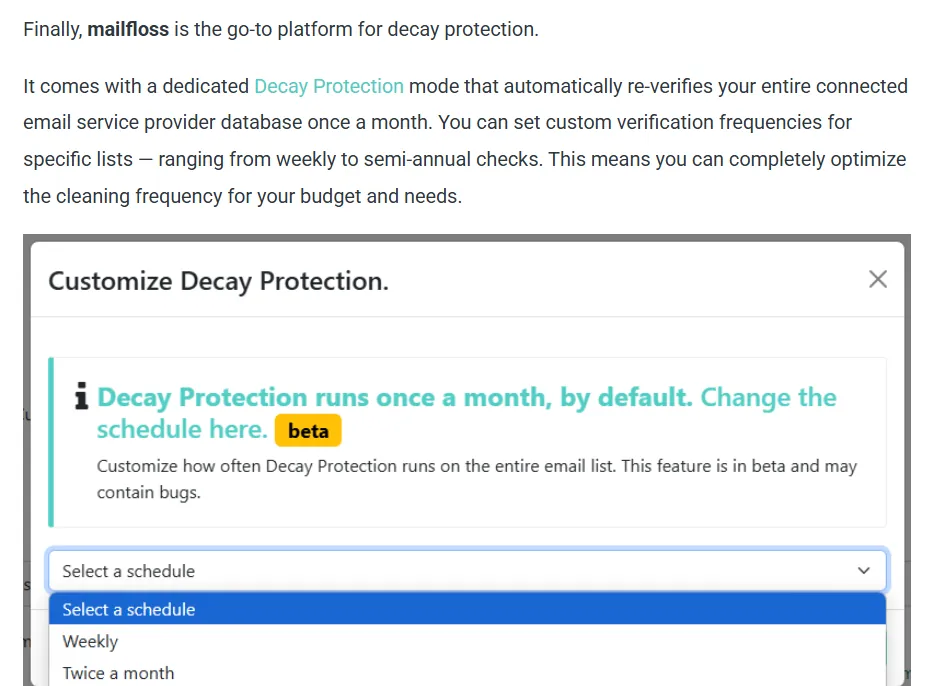
Notice the clear, concrete, and concise explanation.
Just enough to make the platforms distinguishable.
Step 3: Optimizing for Search Engines
There is a lot of talk about AISEO / GEO / LLMSEO online…
I think it’s all 🐂💩
For Mailfloss we focused on:
- Good content
- Good strategy
- Good optimization
(The regular kind of optimization, from 2010.)
And we still got into AI results.
After all, AI was trained on internet data. Made by humans.
If humans can read it, so can AI. If humans value it, so would AI.
Just make sure to have:
- Clear heading structure
- Target keyword in the intro
- Somewhat enticing meta data
- Short URL with the target keyword
- Keyword at the beginning of some headers
- Article Schema with basic info about the article
This helps the article rank, which is correlated with more AI mentions.
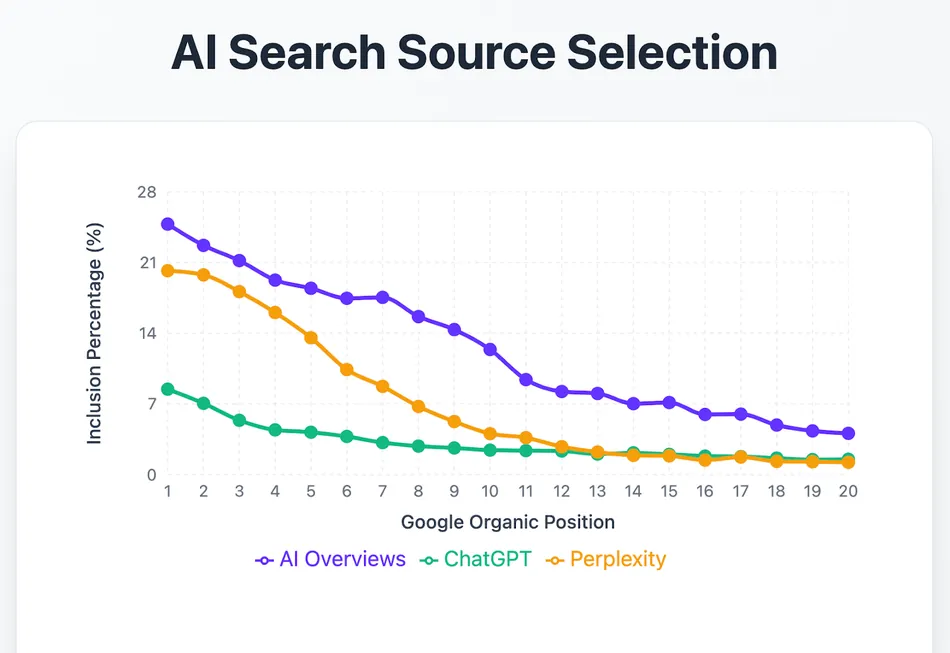
Note this:
Not ranking in top 10?
There’s still a chance to get cited.
(Fits our experience: some Mailfloss articles rank second page yet get cited.)
So difficult keywords shouldn’t deter you.
Go after them.
Eventually, as AIs get cheaper & better with larger contexts, they’ll start going deeper into search results.
Top 10 is really only made for humans because we read so slow.
That era is sunsetting.
BONUS: Tracking mentions in LLMs
Something I wish we’ve done sooner at Mailfloss was set up tracking.
A simple Google Analytics report to see how many clicks we’re getting from LLMs.
To set it up go to Explorations > Start New Exploration.
Under Variables set “Page referrer” as dimensions and “Sessions” as the metric.
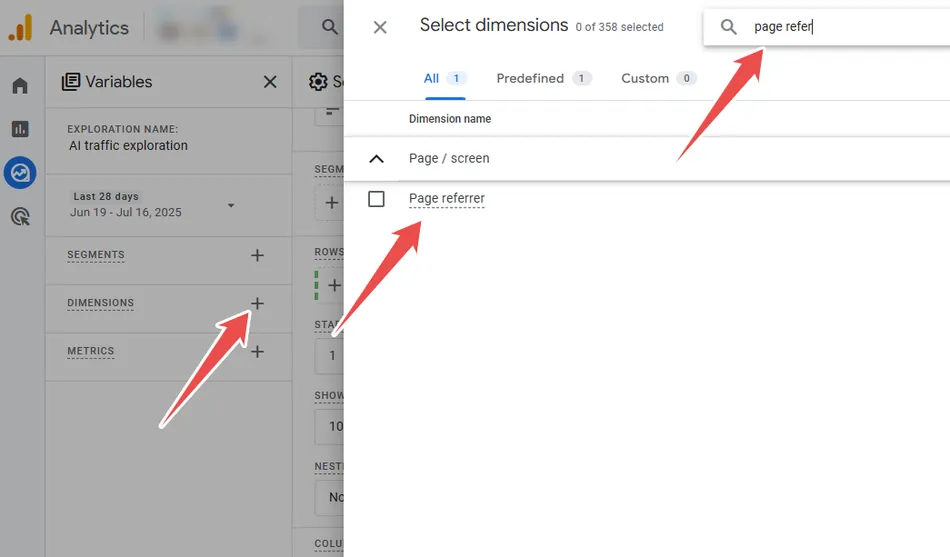
And under Settings select “Page referrer” as rows and “Sessions” as values.
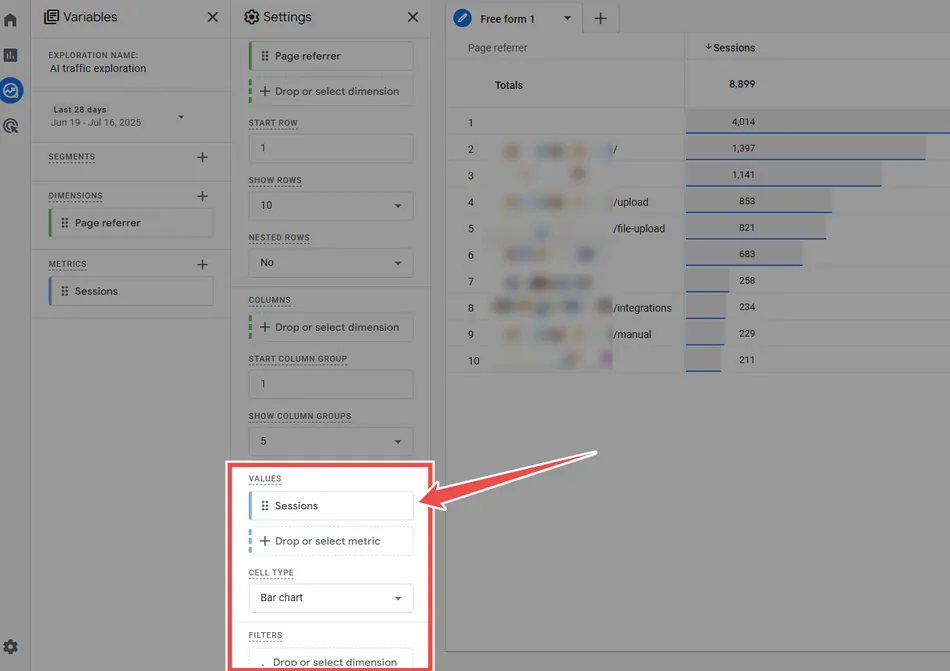
Then add a Filter on “Page referrer” with this regex:
^https:\/\/(www.meta.ai|www.perplexity.ai|chat.openai.com|claude.ai|chat.mistral.ai|gemini.google.com|bard.google.com|chatgpt.com|copilot.microsoft.com)(\/.)?$*
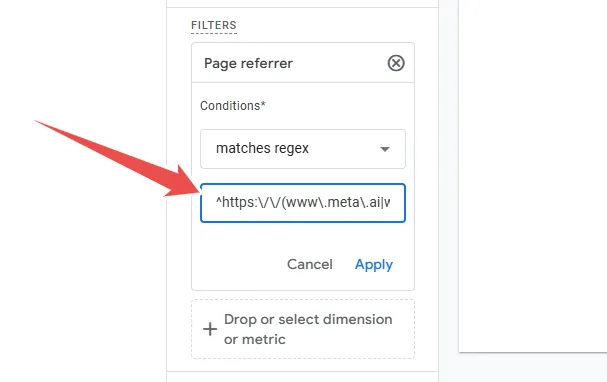
There we go.
Now you should see which LLM is sending traffic your way.
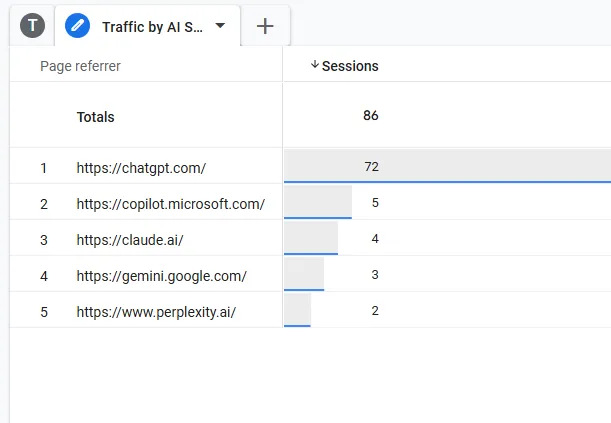
Keep in mind these are all sessions where people actually CLICKED on a link.
In reality LLMs include you in many, many more conversation.
Here’s a longer version by our teammate Matija: How To Track AI Traffic On Your Website
What’s next for Mailfloss?
Here’s where it gets interesting:
Creating comparison clusters around direct competitors (like NeverBounce)…
… Is only scratching the surface.
There are THREE more comparison content types that can get you into AI.
1. Integration Partners
These are platforms that your integration makes better.
For example, Mailfloss connects with Email Marketing Platforms and keeps their database clean.
A clean database is important for email marketers.
So anyone researching an email marketing platform should consider Mailfloss.
Mailfloss’ 40 integration partners open doors to many comparisons:
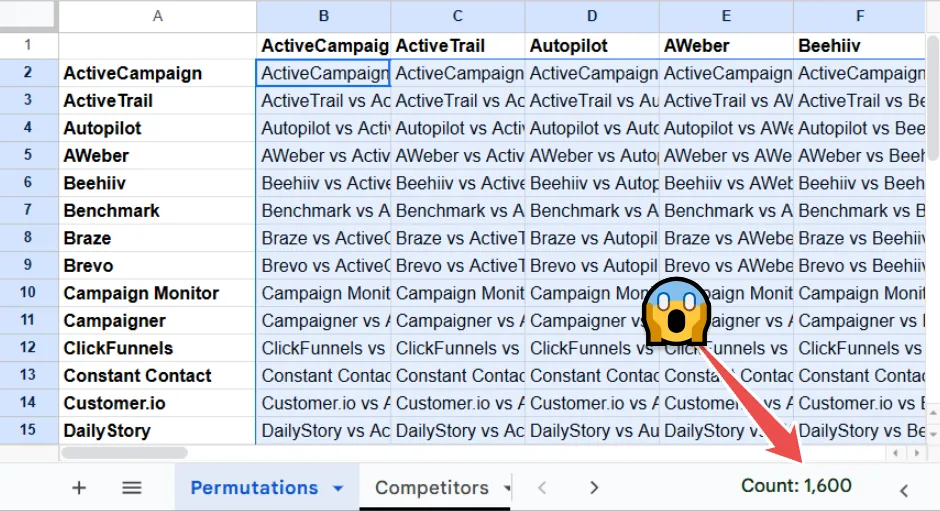
Note: The content game is the same.
Compare the platforms, then include mailfloss in the comparison.
But this time say: “whichever you pick, also get mailfloss to keep your list squeaky clean.”
2. Complementary Products
These are tools your target customers use in their daily workflow.
For example, if someone is doing email marketing, they need to get leads from somewhere.
Most often by running ads to landing pages with some popups.
So anyone researching:
- Ad Attribution Software
- Funnel and Landing Page Builders
- Lead Capture Tools (Popups & Forms)
Would appreciate pitch for Mailfloss, too.
Now this time their pain is elsewhere: not in keeping a clean list but in building a clean list.
Because of that we would highlight a different aspect of mailfloss: their opt-in typo fixer.
The fact is 15% of email opt-ins have a typo.
… meaning 15% of email leads bounce.
… meaning 15% of ad spend is wasted.
But Mailfloss checks every new email opt-in and FIXES any typo.
Thus quietly recovering 15% of ad revenue.
Isn’t this an amazing pitch?
Anyone building email lists would love it.
And get Mailfloss along with their next purchase.
3. Alternative Solutions
These are different solutions to the same problem.
We tried to come up with examples for mailfoss here… but couldn’t.
Mailfloss is in an established vertical, with many competitors, integrations, and complementary platforms.
But this bucket shines with innovative SaaS products, that can’t be placed in any existing category.
(With seemingly no competitors or complementary products.)
For example, if your service turns websites into native mobile apps automatically…
… then your customers don’t need any manual app building tools.
Your platform invalidates the very problem they’re solving.
A counter-example to mailfloss:
“With our solution, you don’t need a prospect’s email address to reach their inbox.”
“So you don’t need to clean email lists”
Makes sense?
If you couldn’t find opportunities in previous categories, you surely will in this one.
What’s next for you?
Our comparison content put Mailfloss into entirely new buying conversations.
Want the same for your SaaS?
First, check if you’re a good fit.
Comparison Clusters work best for platforms that:
- Are unique in some way
- Have clear positioning that resonates
- Have a good amount of product information online
And they work equally well for:
- New and old websites
- B2B, B2C, and Enterprise
- Self-serve funnels and call funnels
If that’s you, here are two options:
- DIY Route: Follow the playbook on your own
- Done-For-You: Get our help by booking a call via this link
We’ll talk about your product, competitive landscape, and how comparison clusters would look like for you.
Then my dialed-in team can create up to 3 comparison articles every 24 hours.
Looking forward to it!
Miha